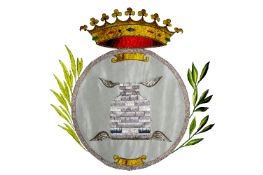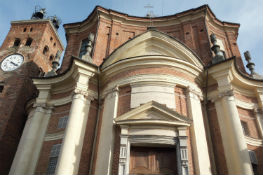Versione italiana English version Version française Versión en español
The Germano di Borgo d'Ale archive includes 110 documents arranged, in the inventory, in three groups: the first lists all the cards, in order of date and character, relating to the members of the family; the second contains a file of 10 cards, largely made up of circular letters from the prefect of Vercelli to the community of Borgo d'Ale, a few administrative acts and documents linked to Germano cards because they are owned by the notary Michele (Germano) mayor of Borgo d'Ale in the years of the Revolution and then merged with the Family Archive. For the same reason, the third group of documents was formed, listed under the heading "Varia", because they relate to different topics and to different people of Borgo d'Ale. This is the last issue, dated between 1765 and 1808. The main nucleus, as is easy to understand, is constituted by the acts concerning the Germanos. It is mostly the purchase of goods, barters, sales. Exceptions are the papers of the lawyer and notary Michael (Germano): licenses for the exercise of the notary, Vittorio Amedeo King of Sardinia (19th June 1752), the Provisional Government of Piedmont (4th January 1799), petitions, licenses of the Royal Chamber of Auditors (16th December 1814) etc. From the examination of these maps, it is possible to draw a historical picture of the family, which is established in Borgo d'Ale, province of Vercelli, divided into several lines, of which one, in the person of Michael (1734), rose to a decent social position. So that the sons of the foretold: Giacomo Maria, Michele, Vitale, Michele, Giacomo, Luigi - in genealogical line - graduated, exercised the advocacy, (except Giacomo Maria, pharmacist in Borgo d'Ale and other Giacomo who was "employed at the Società Alta Italia - expenses control office" in Turin in 1873); Giacomo, son of Vitale, was canon in the cathedral of Vercelli and Giuseppe, brother of Giacomo Maria, surveyor (1750).
The genealogical tree has been written on the documents examined: the year placed in brackets, under the name of each character, is the one found on the act concerning the person under consideration. It was possible to trace the complete genealogy of the main line (Giuseppe Germano 1739 - Luigi 1925) and fragmentary of the Giacomo line (1739). From the examination of the documents are read here and there names of other characters with the same surname (and sometimes with the same name), obviously all of the same family, which is numerous and branched into several branches in Borgo d'Ale. In the oldest documents, we sometimes find, next to the surname Germano, that of Savoy (e.g. Domenico Germano Savoija), which disappeared in the middle of the 18th century. We have used, in drawing up this inventory, the form of the most common surname. The Germanos of Borgo d'Ale were part of those agricultural dynasties quite common in small subalpine towns, whose jambs often date back to ancient times: It is often discovered that they originated from descendants of the feudal lords who held lordship over those places around 1100. For a complete history of the family, it will be sufficient to examine the parish civil status of Borgo d'Ale, the cadastral registers of that community, the notarial minuters and the church stationery of the region. Documents relating to political history are those concerning the community of Borgo d'Ale. From the letters sent by the prefect of the Department of Sesia, it is possible to obtain minute information related to the administration of the community
- Archive inventory (pdf 200 KB)
Historical notes
The name derives from Borgus Alicus, Borgo di Alice, dating back to the Allicus and related to the adjacent village of Alice Castello, probably a village of the Lombard era of the sixth century under the Duchy of Ivrea, but whose records date back to 963, when Emperor Otto I granted the town to Count Aimone of nearby Cavaglià. Initially, the village was built and populated by four ancient adjacent villages, Erbario, Clivolo, Meoglio and Areglio (the latter the most populous), during the marquisate of Arduino d'Ivrea. In 119, however, the act of submission of the village, property of the lords Carlevario, to the Chapter of Vercelli. In 1243 there was a rebellion against the Guelph Chapter by the Ghibelline counts of Cavaglià, however, after a few years, they again submitted to the Ecclesiastical Chapter. All this sparked the distrust of the abbot of Sant'Andrea of Vercelli towards Borgo d'Ale, who invited people to live in the nearby Alice Castello, traditionally more faithful to the Papacy. Towards the beginning of the fourteenth century, then, the village passed to the Visconti of Milan, and finally, in 1374, to the Savoy. Aggregated after the military captaincy of Santhià, the population of the village grew especially after 1417, when the Duke Amedeo VIII of Savoy had the village of Areglio overthrown because of the rebellions of the feudal lord Antonio Tizzoni. The village then lived quiet decades, under the noble Alciati family, until 1610, when King Carlo Emanuele I of Savoy gave it to Andrea Valperga. Still in 1711, the village was again sold to Count Antonio Perracino and, ten years later, to Gaspare Giuseppe Maria Ponsiglione, who ruled it until the Unification of Italy.


